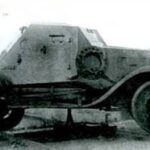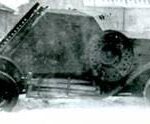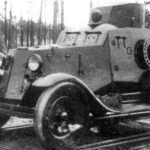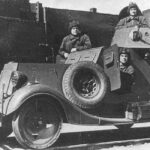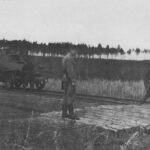Adaptation of Russian armored cars to rail:
In the early thirties, Russian military strategists were looking for an alternative to the massive armored trains implemented during the First World War and the Civil War. A train being by definition heavy, slow to implement and vulnerable because forced to move on a fixed track, it was necessary to create lighter vehicles used for track recognition (generally 5 to 10 km ahead of the train) and transmissions. These vehicles were often armored cars (D8/12, BA-27, FAI, BA20, BA6 and BA10) transformed for rail travel. Moreover, in certain remote areas such as Eastern Siberia, they were often enough on their own.
The light armored car D-8 and its improved version D-12 was produced from 1931 until mid 1932 in the number of about 60 copies at the Mozherez factory in Moscow (railway repair factory). It quickly became apparent that these vehicles were too limited to be effective as armored cars. Rather than sending them to depot, it was decided to use them as draisines for the opening of tracks in coordination with armored trains, indeed the Red Army had planned the construction of special draisines for this task but their design had delayed. With this in mind, a prototype called « brdl » or « brdl-1 » was modified in the Mozherez factory in mid-1933. An ingenious system was developed which allowed the crew to arrive perpendicular to the railway and then pass above (using beams) stopping in the middle, then using a jack placed in the central position to raise the whole vehicle by 20 cm (after having blocked the suspension), to change the wheels from road for railway-specific wheels (hooked on the vehicle), to rotate the vehicle 90° and lower it onto the track. Other mechanisms made it possible to fix the steering once on the rails, to block the suspension springs for lifting. Four wooden beams made it easier to cross the track when arriving. This system made it possible in 10 minutes to obtain either a specialized vehicle for the rail or a classic armored car for the road. This system also allowed a 180° change of direction when on the railway.
Tests were carried out from June 22, 1933 to August 31, 1934 with success, the speed (100 km/h on rails, 80 km/h on the road), the stealth of the vehicle (height: 1.7 m, length: 3.54 m , width: 1.7 m), the provision of even light armor was greatly appreciated. There were also some drawbacks such as the design of the vehicle with its field of fire limited to 15° on either side of the axis, the positioning on the track or the reverse was impossible under fire, the balance of the vehicle had to be perfect when it was lifted by the single jack otherwise the fall was guaranteed.
After these tests with the brdl prototype, the studies to transform the D-8/12 were stopped but lessons were learned to continue the experiment with other vehicles.
In early 1928, the BA-27 was the first Soviet armored car to enter service after the Civil War. This vehicle was the first of national design on the basis of modified AMO F-15. A total of 215 copies were produced until mid-1931. This vehicle quickly showed its limits and at the end of 1931, the Mozherez factory developed a system identical to that of the D-8/12 for use on the railway, the time taken for the transformation was greater (approximately 30 min). The BA-27 was also equipped with a system allowing it to be attached to an armored train or to connect two BA-27s to each other. The track speed was 50 km/h. 35 machines were intended to be sent to the East but the tests carried out quickly showed the limits of the machine: for example getting in and out of the track was very difficult despite the beams, in mid 1934, a prototype was transformed into draisine and renamed BD-37, it was planned to then transform all the other BA-27s but we do not know how many were in reality. As for the D-8/12, lessons were learned from these first experiences and then made it possible to develop more successful models based on light armored cars like the BA-20 ZhD or heavy ones like the BA-I/3/6/ 10 ZhD, these machines then participated in the Second World War with success.



